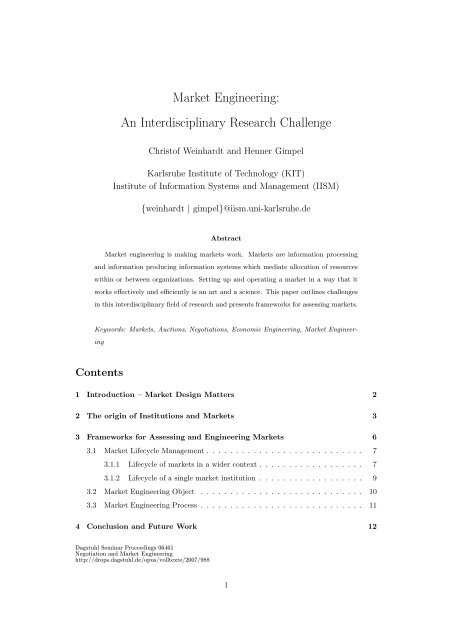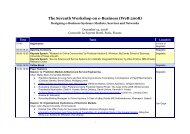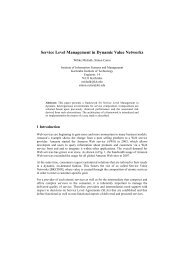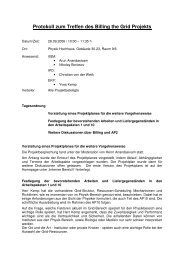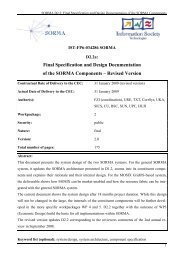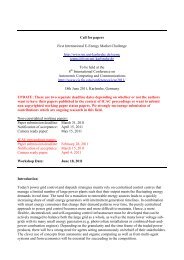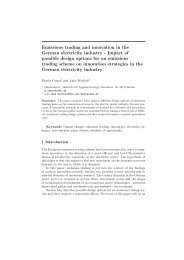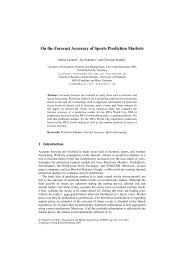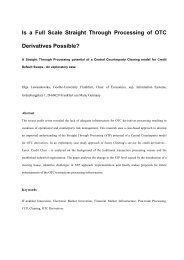Market Engineering - KSRI - Karlsruhe Service Research Institute - KIT
Market Engineering - KSRI - Karlsruhe Service Research Institute - KIT
Market Engineering - KSRI - Karlsruhe Service Research Institute - KIT
Create successful ePaper yourself
Turn your PDF publications into a flip-book with our unique Google optimized e-Paper software.
<strong>Market</strong> <strong>Engineering</strong>:<br />
An Interdisciplinary <strong>Research</strong> Challenge<br />
Christof Weinhardt and Henner Gimpel<br />
<strong>Karlsruhe</strong> <strong>Institute</strong> of Technology (<strong>KIT</strong>)<br />
<strong>Institute</strong> of Information Systems and Management (IISM)<br />
{weinhardt | gimpel}@iism.uni-karlsruhe.de<br />
Abstract<br />
<strong>Market</strong> engineering is making markets work. <strong>Market</strong>s are information processing<br />
and information producing information systems which mediate allocation of resources<br />
within or between organizations. Setting up and operating a market in a way that it<br />
works effectively and efficiently is an art and a science. This paper outlines challenges<br />
in this interdisciplinary field of research and presents frameworks for assessing markets.<br />
Keywords: <strong>Market</strong>s, Auctions, Negotiations, Economic <strong>Engineering</strong>, <strong>Market</strong> <strong>Engineering</strong><br />
Contents<br />
1 Introduction – <strong>Market</strong> Design Matters 2<br />
2 The origin of Institutions and <strong>Market</strong>s 3<br />
3 Frameworks for Assessing and <strong>Engineering</strong> <strong>Market</strong>s 6<br />
3.1 <strong>Market</strong> Lifecycle Management . . . . . . . . . . . . . . . . . . . . . . . . . . . 7<br />
3.1.1 Lifecycle of markets in a wider context . . . . . . . . . . . . . . . . . . 7<br />
3.1.2 Lifecycle of a single market institution . . . . . . . . . . . . . . . . . . 9<br />
3.2 <strong>Market</strong> <strong>Engineering</strong> Object . . . . . . . . . . . . . . . . . . . . . . . . . . . . 10<br />
3.3 <strong>Market</strong> <strong>Engineering</strong> Process . . . . . . . . . . . . . . . . . . . . . . . . . . . . 11<br />
4 Conclusion and Future Work 12<br />
Dagstuhl Seminar Proceedings 06461<br />
Negotiation and <strong>Market</strong> <strong>Engineering</strong><br />
http://drops.dagstuhl.de/opus/volltexte/2007/988<br />
1
1 Introduction – <strong>Market</strong> Design Matters<br />
In 1899, Leo Baekeland sold the rights to his invention, Velox photographic printing paper,<br />
to George Eastman. Velox was the first commercially successful photographic paper ever<br />
developed and the price George Eastman payed was $1 million. Baekeland had planned to<br />
ask $50,000 and to go down to $25,000 if necessary, but—fortunately for him—Eastman<br />
spoke first and offered $1 million (Asimov, 1982). From an economic perspective, the main<br />
lesson of this short historical example is that market design matters. The rules of who<br />
discloses information at which time, how these bids are transformed to prices and allocations<br />
etc. impact the behavior of market participants as well as the market result. Thus, if one<br />
wants to guide behavior of market participants in order to achieve an desired outcome, e.g.<br />
an efficient allocation of resources, one has to carefully engineer the respective market.<br />
New markets emerge constantly and their conscious design ‘is important because markets<br />
don’t always grow like weeds—some of them are hothouse orchids’ which have to be<br />
administered and cultivated; Time and place have to be established, related goods need to<br />
be assembled, or related markets linked so that complementarities can be handled, incentive<br />
problems have to be overcome, etc.’ (Roth, 2002). In this context, where oftentimes the<br />
point is not to understand the world but to change it, ‘economics looks more like engineering<br />
than it does pure science. Just as a civil engineer applies principles of physics and mechanics<br />
to design bridges, economists apply principles of economic analysis to design exchange<br />
mechanisms’ (Varian, 2002).<br />
The engineering of the FCC spectrum auctions in the US (e.g. McAfee and McMillan<br />
(1996)), the job market for graduates in medicine (Roth and Pearson, 1999), the electric<br />
power market in California (Wilson, 2002), and the spectrum license auctions in Europe<br />
(Klemperer, 2002) all teach several important lessons. <strong>Market</strong> engineering requires ...<br />
1. ... an integrated, holisitic view on markets comprising the microstructure, the business<br />
structure, the IT infrastructure (if existent), the design of the trading object, the<br />
regulatory framework etc.<br />
2. ... a multiplicity of methodologies including theoretical modeling (microeconomics,<br />
game theory, industrial organization theory, value chain theory, Monte Carlo and<br />
agent-based simulations etc.), empiricism (lab experiments, field experiments, analysis<br />
of field data etc.), and constructive approaches (creation of innovative artifacts<br />
like e.g. software prototypes).<br />
3. ... an interdisciplinary approach to cope with the complexity of the integrated, holisitic<br />
view and to provide the multiplicity of methodologies. Especially relevant are economics,<br />
business administration, information systems, computer science, law, sociology,<br />
and psychology.<br />
2
4. ... the understanding that details matter. There are no standard market designs<br />
which can easily be copied from one application to another—a market mechanism has<br />
to be engineered with attention to details and rigorous consideration of the specific<br />
requirements and surrounding conditions.<br />
Besides the examples for market engineering mentioned above, another area of recent development<br />
that clearly underscores the necessity of conscious engineering of markets is the<br />
increasing presence and relevance of electronic markets. While in traditional physical markets<br />
the rules might evolve over time, electronic markets make the conscious and structured<br />
design of the rules of interaction indispensable, as they have to be implemented in computer<br />
systems and do not allow spontaneous changes. A predominant domain where economic<br />
engineering has been applied in the last decade is market design (Roth, 2002; Varian, 2002);<br />
Weinhardt, Holtmann, and Neumann (2003) coined the term market engineering. 1<br />
2 The origin of Institutions and <strong>Market</strong>s<br />
<strong>Market</strong>s have been studied in various disciplines and, not surprisingly, many renowned<br />
researchers have worked on understanding the origin and working of markets: In neoclassical<br />
economic theory, a market is a frictionless place of exchange. It is made up of supply and<br />
demand. The market equates supply and demand and thereby takes care of the allocation<br />
problem, if permitted to do so. In new institutional economics, it is a mechanisms which<br />
usage creates transaction costs. In information systems, markets are inter-organizational<br />
information system. In jurisprudence it is a bundle of contracts and topic for regulation.<br />
The outcome of a market are allocations and information.<br />
Friedrich August von Hayek. 2<br />
In order to equate supply and demand, as neoclassic economic<br />
theory postulates, the market has to have information on its participants’ preferences.<br />
If so, the allocation of goods and services is a relatively easy optimization problem—von<br />
Hayek (1945, pp. 519-520) puts it as follows: ‘If we possess all the relevant information, if we<br />
can start out from a given system of preferences, and if we command complete knowledge of<br />
available means, the problem which remains is purely one of logic. This, however, is emphatically<br />
not the economic problem which society faces. And the economic calculus which we<br />
have developed to solve this logical problem, though an important step toward the solution<br />
of the economic problem of society, does not yet provide an answer to it. The reason for this<br />
is that the “data” from which the economic calculus starts are never for the whole society<br />
“given” to a single mind which could work out the implications and can never be so given.<br />
1 See also Neumann (2004) for a more extensive discussion.<br />
2 In 1974, Friedrich August von Hayek received the Nobel Prize in Economics for his pioneering work in<br />
the theory of money and economic fluctuations and for his penetrating analysis of the interdependence of<br />
economic, social, and institutional phenomena.<br />
3
The peculiar character of the problem of a rational economic order is determined precisely by<br />
the fact that the knowledge of the circumstances of which we must make use never exists in<br />
concentrated or integrated form but solely as the dispersed bits of incomplete and frequently<br />
contradictory knowledge which all the separate individuals possess. The economic problem<br />
of society is thus not merely a problem of how to allocate “given” resources—if ”given” is<br />
taken to mean given to a single mind which deliberately solves the problem set by these<br />
“data.” It is rather a problem of how to secure the best use of resources known to any of the<br />
members of society, for ends whose relative importance only these individuals know. Or, to<br />
put it briefly, it is a problem of the utilization of knowledge which is not given to anyone in<br />
its totality.’ Thus, according to von Hayek, markets are no mechanical optimization device<br />
but a mechanism to exchange and process information of individual market participants in<br />
order to facilitate exchange transactions.<br />
Ronald H. Coase. 3 As this information processing is not costless, Coase (1937, 1960,<br />
1988) discussed the role of so called transaction costs for the existence of markets. The<br />
main sources of costs related to transactions are search and information costs, bargaining and<br />
decision costs, and policing and enforcement costs. In Coase’s view, markets ‘are institutions<br />
that exist to facilitate exchange, that is, they exist in order to reduce the cost of carrying<br />
out exchange transactions. In an economic theory which assumes that transaction costs<br />
are nonexistent, markets have no function to perform, and it seems perfectly reasonable to<br />
develop the theory of exchange by an elaborate analysis of individuals exchanging nuts for<br />
apples on the edge of the forest or some similar fanciful example. This analysis certainly<br />
shows why there is a gain from trade, but it fails to deal with the factors which determine<br />
how much trade there is or what goods are traded. And when economists do speak of market<br />
structure, it has nothing to do with the market as an institution but refers to such things<br />
as the number of firms, product differentiation, and the like, the influence of the social<br />
institutions which facilitate exchange being completely ignored.’ (Coase, 1988, pp. 7-8).<br />
George J. Stigler. 4<br />
This view is corroborated by Stigler, who stressed that the ‘world<br />
of zero transaction costs turns out to be as strange as the physical world with zero friction.<br />
Monopolies would be compensated to act like competitors, and insurance companies and<br />
banks would not exist’ (Stigler, 1972, p. 12).<br />
3 In 1991, Ronald H. Coase received the Nobel Prize in Economics for his discovery and clarification of<br />
the significance of transaction costs and property rights for the institutional structure and functioning of<br />
the economy.<br />
4 In 1982, George J. Stigler received the Nobel Prize in Economics for his seminal studies of industrial<br />
structures, functioning of markets, and causes and effects of public regulation.<br />
4
Douglass C. North. 5 According to Coase and Stigler, a market is more than supply and<br />
demand and transaction costs have to be taken into account: A market is an institution<br />
and its working and performance are determined by the market structure, i.e. the rules<br />
of interaction. According to North (1991, p. 97), ‘Institutions are the humanly devised<br />
constraints that structure political, economic and social interaction. They consist of both<br />
informal constraints (sanctions, taboos, customs, traditions, and codes of conduct), and<br />
formal rules (constitutions, laws, property rights).’ Even if North (1991) does not discuss the<br />
market structure in Coase’s (1988) view, his perspective on institutions helps understanding<br />
what a market institution is. A market is a set of humanly devised constraints that exist in<br />
order to reduce the cost of carrying out exchange transactions.<br />
Vernon L. Smith. 6<br />
If a market institution is a set of humanly devised constraints, the<br />
question on the origin of these constraints arises: Where does a market structure come<br />
from? Following Smith (2003), there are two main origins of market institutions as a rational<br />
order: conscious design and undirected evolution. Already in the seventeenth century, the<br />
French philosopher and mathematician René Descartes ‘contended that all the useful human<br />
institutions were and ought to be deliberate creation(s) of conscious reason [...] a capacity of<br />
the mind to arrive at the truth by a deductive process from a few obvious and undoubtable<br />
premises’ (von Hayek, 1967, p. 85). Accordingly, many market structures are determined by<br />
conscious design.<br />
On the other hand, undesigned, evolutionary processes determine market structures.<br />
Different market places and market structures compete with each other and the fittest<br />
markets survive. ‘Adam Smith developed the idea of emergent order for economics. Truth<br />
is discovered in the form of the intelligence embodied in rules and traditions that have<br />
formed, inscrutably, out of the ancient history of human social interactions. This is the<br />
antithesis of the anthropocentric belief that if an observed social mechanism is functional,<br />
somebody in the unrecorded past must have used reason consciously to create it to serve its<br />
perceived intended purposes.’ (Smith, 2003, p. 470)<br />
Deliberate construction and spontaneous evolution both affect market institutions. ‘Constructivism<br />
is indeed an engine for generating variation, but is far too limited in its ability<br />
to comprehend and apply all the relevant facts to serve the process of selection, which is<br />
better left to ecological processes.’ (Smith, 2003, p. 470)<br />
5 In 1993, Douglass C. North received the Nobel Prize in Economics for having renewed research in<br />
economic history by applying economic theory and quantitative methods in order to explain economic and<br />
institutional change.<br />
6 In 2002, Vernon L. Smith received the Nobel Prize in Economics for having established laboratory experiments<br />
as a tool in empirical economic analysis, especially in the study of alternative market mechanisms.<br />
5
3 Frameworks for Assessing and <strong>Engineering</strong> <strong>Market</strong>s<br />
Following the historical excursus on markets in Section 2, a market is defined as follows:<br />
Definition 3.1 (<strong>Market</strong>) A market is a set of humanly devised rules that structure the<br />
interaction and exchange of information by self-interested participants in order to carry out<br />
exchange transactions at a relatively low cost.<br />
As such, markets are constrained by a socio-cultural and legal framework and can be<br />
seen as<br />
• the equation of demand and supply,<br />
• a set of constraints which have to be established,<br />
• a set of constraints which compete for survival,<br />
• an information processing system,<br />
• an entrepreneurial activity, and<br />
• a service.<br />
<strong>Engineering</strong> markets includes the conscious, structured, systematic, and theoretically<br />
founded procedure of analyzing, designing and introducing market institutions. It can be<br />
defined as follows:<br />
Definition 3.2 (<strong>Market</strong> <strong>Engineering</strong>) <strong>Market</strong> engineering is the process of consciously<br />
setting up or re-structuring a market in order to make it an effective and efficient means for<br />
carrying out exchange transactions.<br />
Objectives of market engineering are<br />
• to analyze and design transaction objects, microstructures, infrastructures, and business<br />
structures of markets,<br />
• to identify areas of application in which market-based coordination is an effective and<br />
efficient means of coordination, and<br />
• to develop methods, procedures, tools, and knowledge for the engineering of markets<br />
as well as the identification of areas of application for market-based coordination.<br />
In light of the multiple facets of markets and market engineering, it is hardly surprising<br />
that several frameworks can and should be employed to understand, build, and run markets.<br />
Some of them are outlined in the following. 7<br />
7 Note, that not all of these ideas on engineering markets are entirely new here. See e.g. Holtmann and<br />
Neumann (2003); Neumann and Holtmann (2004); Neumann (2004); Neumann et al. (2006); Weinhardt<br />
et al. (2007).<br />
6
3.1 <strong>Market</strong> Lifecycle Management<br />
Like any product or service, a market follows a lifecycle. As pointed out in Section 2 by<br />
quoting Coase (1988, p. 8), the term market is ambiguous: on the one hand it refers to a<br />
market institution like the NYSE, for example, and on the other hand it refers to a wider<br />
context like the stock market in general, for example.<br />
3.1.1 Lifecycle of markets in a wider context<br />
New markets—not market institutions but markets in a wider context—emerge constantly,<br />
e.g. markets for electricity, emission rights, spectrum licenses, or markets for granting private<br />
credits. The typical phases of a product lifecycle transfer to a market lifecycle, they are<br />
sketched in Figure 1.<br />
$<br />
sales<br />
profits<br />
time<br />
emerging growth maturity decline<br />
(e.g. markets for<br />
private credits)<br />
(e.g. markets for<br />
emission rights)<br />
(e.g. stock markets, B2C and<br />
C2C online markets)<br />
(e.g. B2B<br />
online markets)<br />
Figure 1: Stylized lifecycle of a market in general<br />
Emerging: While a market is emerging, it’s existence is hardly known to the public. Operators<br />
of market institutions have rather few competition and have to concentrate on<br />
R&D and engineering, define the product to be traded, and create a customer need for<br />
exchange transactions and an exchange institution, i.e. a marketplace. In this phase,<br />
market operators have rather high expenditures for the aforementioned activities and<br />
cannot yet cover them with revenues generated by the marketplace. Thus, overall<br />
profit is at first negative, as it is virtually for any business one starts in an emerging<br />
market.<br />
An example for a currently emerging market is the market for exchanging credits<br />
between private persons via Internet platforms. This direct interaction of creditors<br />
and borrowers bypasses the conventional intermediation by banks.<br />
Growth: In this second phase, the market in general is growing rapidly and new market<br />
operators likely enter to compete for revenues. Traditional strategies are to emphasize<br />
7
marketing, focus on quality, and manage rapid growth of the network of market participants,<br />
the market operator’s organizational structure, and likely the employed IT<br />
systems.<br />
Network effects play a crucial role in this phase. In many two-sided markets, participants<br />
directly benefit from a high competition of potential counterparts in an exchange<br />
transaction. eBay and its competitors are an example: In many countries eBay is by<br />
far the largest B2C and C2C (and partly B2B) online marketplace. When a buyer<br />
chooses a market platform to purchase a good, she likely picks eBay as there are many<br />
sellers and she thus expects a high chance to find an auction with a low price. On<br />
the contrary, a seller likely sets up his auction on eBay as there are many buyers who<br />
compete for the good and the seller hopes for a high price. 8 See e.g. Rochet and Tirole<br />
(2003); Ellison et al. (2004); Chen et al. (2006) for discussions of the importance of<br />
size and network effects for competing market institutions.<br />
An example for a market in the growth phase is the market for emission rights in the<br />
European Union. It is well known that emission rights are traded today and trading<br />
volume will likely increase over the next years. <strong>Market</strong> operators try to attract trading<br />
volume to become the incumbent and deter entrance by other market operators.<br />
Maturity: When a market is mature, competition among market operators intensifies and<br />
prices for their services fall. Operators have to focus on their costs to survive the price<br />
competition and/ or to focus on niches like special market segments or additional<br />
services.<br />
Stock markets, for example, are rather mature and in Europe we see a fierce competition<br />
among market operators for the relatively constant market volume.<br />
This<br />
includes price competition, quality differentiation, plans for mergers and consolidation<br />
of market institutions etc.<br />
Decline: When a market declines because there is no need for transactions any more or<br />
participants organize via another venue, high-cost and low-share competitors exit. The<br />
remaining market operators further focus on being low-cost or niche players.<br />
B2B online markets are an example for a once bigger market which declined.<br />
do not want to claim that there is no need for B2B markets but rather observe that<br />
during the e-commerce hype and dot.com boom there was an exaggerated enthusiasm<br />
for B2B Internet market platforms and many of them did not survive the decline of<br />
this hype.<br />
8 Note that on the contrary a buyer would like to choose a marketplace where there is low competition<br />
with other buyers. The same holds for sellers.<br />
We<br />
8
Besides markets which occur ‘naturally’ as a product or service emerges and the desire<br />
for exchanging it comes up, there are markets strictly controlled by regulators. Spectrum<br />
license auctions are an example where a regulator (a country), defines the good (the licenses),<br />
determines beginning and end of a market institution (an auction), and runs the market<br />
without any competition, as no other market operator can enter the primary market for<br />
spectrum licenses.<br />
3.1.2 Lifecycle of a single market institution<br />
While the previous section outlined the lifecycle of markets in general, Figure 2 shows the<br />
lifecycle of a single market institution. The lifecycle starts by a market engineer setting of<br />
the design of a new market. The major phases during design time are designing, testing,<br />
and implementing the set of constraints of the new market institution as well as its infrastructure,<br />
e.g. a software. These phases will be detailed in Section 3.3; software tools like the<br />
meet2trade platform (Weinhardt et al., 2006), for example, support the work of a market<br />
engineer in these phases.<br />
Figure 2: Stylized lifecycle of a market institution<br />
Once the market is ready for operation, it has to be introduced by allowing trades to<br />
access the market. Likely this will be accompanied by marketing activity to attract traders<br />
and gain liquidity. Running, monitoring, controlling, and managing the market institution<br />
are the phases which follow. Here, the market operator has to provision the market service<br />
and to monitor trading to detect, for example, malicious behavior (e.g. Blume et al., 2006).<br />
In case the performance of the market does not match the requirements, or either the<br />
objectives of the market operator or the environmental conditions have changed, the market<br />
operator has to re-design the market institution.<br />
9
For some Internet market platforms, like eBay and Amazon, an interesting tendency can<br />
be observed: after the initial introduction of the electronic market platform, there is no clear<br />
cut distinction between design-time and runtime any more. This equals the fusion of designand<br />
runtime of other Internet services like Google, for example. These service operators<br />
can continuously experiment with subsets of their user groups (e.g. chosen by random or by<br />
country of origin) and the real-time feedback allows continuous improvement in the design<br />
of their online businesses. This leads to rapid and subtle innovations and allows incumbents<br />
to gain a competitive advantage over potential new entrants.<br />
3.2 <strong>Market</strong> <strong>Engineering</strong> Object<br />
Figure 3 shows the so called market engineering object, i.e. a static view on pivotal elements<br />
of a market which a market engineer should bear in mind.<br />
<strong>Market</strong> Outcome<br />
Agent Behavior<br />
<strong>Market</strong> Structure<br />
Microstructure<br />
(IT) Infrastructure<br />
Business<br />
Structure<br />
Transaction Object<br />
Socio-economic and Legal Environment<br />
Figure 3: <strong>Market</strong> <strong>Engineering</strong> Object<br />
The objective of a market engineer is to achieve a desired market outcome or performance.<br />
To do so, she can design the transaction object as well as the market structure. The market<br />
structure comprises the market microstructure, the (IT) infrastructure, and the business<br />
structure.<br />
These designed elements—the transaction object and the market structure—have only<br />
indirect effect on the market outcome. The link from the structure to the outcome lies<br />
in the behavior of market participants. It is the behavior of market participants which<br />
makes the engineering of markets a major challenge as their are no direct cause-effect relationships<br />
between a market’s structure and its performance. In an abstract setting like a<br />
10
game-theoretic model with hyper-rational, utility-optimizing players, their might be direct<br />
cause-effect relationships. However, in the real world, where market participants are boundedly<br />
rational (e.g. Simon, 1955, 1957; Selten, 2001) and are prone to cognitive biases (e.g.<br />
Neale and Bazerman, 1991; Bazerman, 2006; Gimpel, 2007), the relation of market structure<br />
and market outcome is not straight forward. Usually, market engineers employ a variety<br />
of methodologies to asses the impact a specific market structure has on the participants’<br />
behavior and thus the outcome; these include especially theoretical modelling (game theory,<br />
auction theory, mechanism design etc.) and empirical research (lab and field experiments<br />
etc.).<br />
The socio-economic and legal environment comprises elements which the market engineer<br />
cannot directly influence; examples are the participants’ cultural background and norms,<br />
their preferences, and the applicable laws. See e.g. Neumann (2004) for a discussion of<br />
the design parameters of market structures, Seifert (2006) for an example of studying the<br />
microstructure, Rolli et al. (2006) for an example of approaching the IT infrastructure, and<br />
Burghardt (2006) for an example analyzing the business structure of markets.<br />
3.3 <strong>Market</strong> <strong>Engineering</strong> Process<br />
While the market engineering object is a static view on markets, the following process<br />
structures the procedure of engineering a market institution. It is displayed in Figure 4 below<br />
based on Figure 1 of Weinhardt et al. (2007). Besides the phases of the market engineering<br />
process, Figure 4 lists some methods and tools commonly employed in the different phases.<br />
The market engineering process—a more detailed process model of the lifecycle of a market<br />
institution as displayed in Figure 2—starts with an environmental analysis. Important<br />
sub-phases are the design of the transaction object, the identification of potential participants,<br />
i.e. customers of the market service, and the analysis of requirements. The design<br />
phase deals with the microstructure, the (IT) infrastructure, and the business structure<br />
of the market institution and the evaluation phase assesses the participants behavior (cf.<br />
Figure 3). Following are implementation and introduction of the designed market. The<br />
enumeration of methods and tools in Figure 4 is by far not extensive but is meant to give a<br />
better understanding of a market engineers work in the different phases.<br />
The process model resembles a waterfall model from e.g. software engineering. The<br />
arrows indicate a basically sequential process. However, obviously iterations are sometimes<br />
useful and necessary and the model allows for such iterations. The most obvious one—from<br />
evaluation to design in case the evaluation shows that the (preliminary) design does not<br />
(yet) fulfill the requirements—is sketched in the figure. The less frequent ones are omitted<br />
here for clarity.<br />
See Weinhardt et al. (2003); Neumann (2004); Weinhardt et al. (2007) for more detailed<br />
11
Input<br />
Process Methods Tools<br />
Objectives<br />
Environmental<br />
Analysis<br />
Survey<br />
Interview<br />
SWOT Analysis<br />
Literature Review<br />
Requirements<br />
List<br />
Design<br />
Mechanism Design<br />
Parametric Design<br />
Methods from<br />
Computer Science/<br />
IS<br />
meet2trade<br />
AuctionBot<br />
AB3D<br />
Conceptual<br />
Model<br />
Evaluation<br />
Theoretical<br />
Modeling<br />
Empirical Studies<br />
Prototyping<br />
zTree<br />
Repast<br />
AMASE, MES<br />
jCase<br />
j<strong>Market</strong>s<br />
Preliminary<br />
Requirement<br />
Satisfaction List<br />
Implementation<br />
Conceptual<br />
Modeling<br />
Methods from<br />
Software<br />
<strong>Engineering</strong><br />
Rational Modeler<br />
Innovator<br />
Together<br />
<strong>Market</strong><br />
System<br />
Introduction<br />
Training<br />
Methods from<br />
<strong>Market</strong>ing<br />
Figure 4: <strong>Market</strong> <strong>Engineering</strong> Process<br />
discussions of the market engineering process and Schnizler (2007) for an example of applying<br />
the process.<br />
4 Conclusion and Future Work<br />
<strong>Market</strong> engineering is the process of consciously setting up or re-structuring a market in<br />
order to make it an effective and efficient means for carrying out exchange transactions.<br />
More bluntly, market engineering is making markets work. This requires an integrated,<br />
holisitic view on markets, a multiplicity of methodologies, an interdisciplinary approach,<br />
and the understanding that details matter.<br />
To help market engineers in assessing and designing markets, we presented three frameworks:<br />
<strong>Market</strong> Lifecycle Management, the <strong>Market</strong> <strong>Engineering</strong> Object, and the <strong>Market</strong><br />
<strong>Engineering</strong> Process. Along this presentation, several yet unresolved questions and research<br />
challenges have been pointed out. A major challenge lies in integrating the detailed results<br />
different disciplines already achieved to a holistic, interdisciplinary view on engineering markets.<br />
12
Acknowledgements<br />
The authors wish to thank numerous researchers who over the last years helped in advancing<br />
the outlined view on market engineering. Especially the previous work and ideas of colleagues<br />
at the <strong>Institute</strong> of Information Systems and Management (IISM) at Universität <strong>Karlsruhe</strong><br />
(TH) were a valuable source of inspiration.<br />
References<br />
Asimov, I. (1982). Asimov’s Biographical Encyclopedia of Science and Technology (2 ed.).<br />
Garden City: Doubleday.<br />
Bazerman, M. H. (2006). Judgment in Managerial Decision Making (6. ed.). New York:<br />
John Wiley & Sons.<br />
Blume, M., C. Weinhardt, and D. Seese (2006). Using network analysis for fraud detection<br />
in electronic markets. In T. Dreier, R. Studer, and C. Weinhardt (Eds.), Information<br />
Management and <strong>Market</strong> <strong>Engineering</strong>, Volume 4 of Studies on eOrganisation and <strong>Market</strong><br />
<strong>Engineering</strong>, pp. 101–112. <strong>Karlsruhe</strong>: Universitätsverlag <strong>Karlsruhe</strong>.<br />
Burghardt, M. (2006). Nonlinear transaction pricing in the securities trading value chain.<br />
In N. Jennings, G. Kersten, A. Ockenfels, and C. Weinhardt (Eds.), Negotiation and<br />
<strong>Market</strong> <strong>Engineering</strong>, Number 06461 in Dagstuhl Seminar Proceedings. Internationales<br />
Begegnungs- und Forschungszentrum (IBFI), Schloss Dagstuhl, Germany.<br />
Chen, X., C. Weinhardt, and S. Berninghaus (2006). Modeling and simulating competition<br />
among e-auction marketplaces. In T. Dreier, R. Studer, and C. Weinhardt (Eds.), Information<br />
Management and <strong>Market</strong> <strong>Engineering</strong>, Volume 4 of Studies on eOrganisation and<br />
<strong>Market</strong> <strong>Engineering</strong>, pp. 113–124. <strong>Karlsruhe</strong>: Universitätsverlag <strong>Karlsruhe</strong>.<br />
Coase, R. H. (1937). The nature of the firm. Economica 4 (16), 386–405.<br />
Coase, R. H. (1960). The problem of social cost. Journal of Law and Economics 3, 1–44.<br />
Coase, R. H. (1988). The Firm, the <strong>Market</strong>, and the Law. Chicago: University of Chicago<br />
Press.<br />
Ellison, G., D. Fudenberg, and M. Moebius (2004). Competing auctions. European Economic<br />
Review 20 (1), 30–66.<br />
Gimpel, H. (2007). Preferences in Negotiations: The Attachment Effect, Volume 595 of<br />
Lecture Notes in Economics and Mathematical Systems. Berlin: Springer.<br />
13
Holtmann, C. and D. Neumann (2003). <strong>Market</strong> and firm – two sides of a coin. In Proceedings<br />
of the 10th <strong>Research</strong> Symposium on Emerging Electronic <strong>Market</strong>s (RSEEM 2003),<br />
Bremen.<br />
Klemperer, P. (2002). How (not) to run auctions: The european 3g telecom auctions.<br />
European Economic Review 46 (4-5), 829–845.<br />
McAfee, R. P. and J. McMillan (1996). Analyzing the airwaves auction. Journal of Economic<br />
Perspectives 10, 159–175.<br />
Neale, M. A. and M. H. Bazerman (1991). Cognition and Rationality in Negotiation. New<br />
York: Free Press.<br />
Neumann, D. (2004). <strong>Market</strong> <strong>Engineering</strong> - A Structured Design Process for Electronic<br />
<strong>Market</strong>s. Ph. D. thesis, School of Economcis and Business <strong>Engineering</strong>, University of<br />
<strong>Karlsruhe</strong>, Germany.<br />
Neumann, D. and C. Holtmann (2004). Embodiment design in market engineering. In<br />
Proceedings of the 11th <strong>Research</strong> Symposium on Emerging Electronic <strong>Market</strong>s (RSEEM<br />
2004), Dublin, pp. 85–96.<br />
Neumann, D., C. Holtmann, and C. Weinhardt (2006). Using blueprints for engineering<br />
electronic market services. In The First International Workshop on <strong>Service</strong> Intelligence<br />
and <strong>Service</strong> Science (SISS 2006), Hong Kong.<br />
North, D. C. (1991). Institutions. Journal of Economic Perspectives 5 (1), 97–112.<br />
Rochet, J. and J. Tirole (2003). Platform competition in two-sided markets. Journal of the<br />
European Economic Association 1 (4), 990–1029.<br />
Rolli, D., S. Luckner, H. Gimpel, and C. Weinhardt (2006). A descriptive auction language.<br />
Electronic <strong>Market</strong>s – The International Journal 16 (1), 51–62.<br />
Roth, A. E. (2002). The economist as an engineer: Game theory, experimentation, and<br />
computation as tools for design economics. Econometrica 70 (4), 1341–1378.<br />
Roth, A. E. and E. Pearson (1999). The redesign of the matching market for american<br />
physicians: Some engineering aspects of economic design. American Economic Review 89,<br />
748–780.<br />
Schnizler, B. (2007, Mai). Resource Allocation in the Grid: A <strong>Market</strong> <strong>Engineering</strong> Approach.<br />
Ph. D. thesis, School of Economcis and Business <strong>Engineering</strong>, Universität <strong>Karlsruhe</strong> (TH).<br />
Seifert, S. (2006). Posted Price Offers in Internet Auction <strong>Market</strong>s, Volume 580 of Lecture<br />
Notes in Economics and Mathematical Systems. Berlin: Springer.<br />
14
Selten, R. (2001). What is bounded rationality? In G. Gigerenzer and R. Selten (Eds.),<br />
Bounded Rationality: The Adaptive Toolbox, pp. 13–36. Cambridge: MIT Press.<br />
Simon, H. A. (1955). A behavioral model of rational choice. Quarterly Journal of Economics<br />
69 (1), 99–118.<br />
Simon, H. A. (1957). Models of Man. New York: John Wiley & Sons.<br />
Smith, V. L. (2003). Constructivist and ecological rationality in economics. American<br />
Economic Review 93 (3), 465–508.<br />
Stigler, G. J. (1972). The law and economics of public policy: A plea to the scholars. The<br />
Journal of Legal Studies 1 (1), 1–12.<br />
Varian, H. R. (2002). Avoiding the pitfalls when economics shifts from science to engineering.<br />
New York Times (August 29, 2002).<br />
von Hayek, F. A. (1945). The use of knowledge in society. American Economic Review 35 (4),<br />
519–530.<br />
von Hayek, F. A. (1967). Studies in Philosophy, Politics and Economics. Chicago: University<br />
of Chicago Press.<br />
Weinhardt, C., C. Holtmann, and D. Neumann (2003). <strong>Market</strong> engineering. Wirtschaftsinformatik<br />
45 (6), 635–640.<br />
Weinhardt, C., D. Neumann, and C. Holtmann (2003). <strong>Market</strong>-engineering. Wirtschaftsinformatik<br />
45, 635–640.<br />
Weinhardt, C., B. Schnizler, and S. Luckner (2007). <strong>Market</strong> engineering. In Group Decision<br />
and Negotiation (GDN) 2007, Montreal.<br />
Weinhardt, C., C. van Dinther, M. Grunenberg, K. Kolitz, M. Kunzelmann, J. Mäkiö,<br />
I. Weber, and H. Weltzien (2006). CAME-Toolsuite meet2trade, Volume 3 of Studies on<br />
eOrganisation and <strong>Market</strong> <strong>Engineering</strong>. <strong>Karlsruhe</strong>: Universitätsverlag <strong>Karlsruhe</strong>.<br />
Wilson, R. (2002). Architecture of power markets. Econometrics 70, 1299–1340.<br />
15


